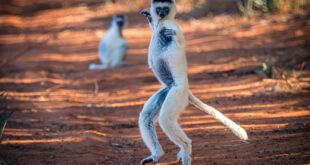A Malagasy legend tells that there were times when the trees could still walk. At that time there was also a large lake whose water was so clear and calm that it lay there like a mirror.
Whenever they passed the lake, the baobabs stopped. They became sad when they saw their own appearance reflected in the water. The other trees were slender and had smooth bark, they were rich in leaves and flowers. The baobabs, however, were wrinkled and bulbous and not at all handsome. Sad and angry they complained to their creator Zanahary, why only they had got such an ugly appearance. But Zanahary liked the baobabs just the way they were. He said: “Look, each of my creations is unique. It is the variety that makes you unique. And you are not the most beautiful, but you are the largest of all trees!” So the baobabs were content to have at least that characteristic. And so they continued to grow. Birds liked to nest in the branches, lemurs liked to rest in the shade of the thick trunks.
But the bigger they grew, the more the baobabs looked down on the many small bushes, trees, and animals. With time, the big baobabs imagined that they were something better. They admired their size in the water of the lake and made fun of the other creatures of God. Zanahary saw this and advised the baobabs to be less self-important. But the big trees ignored his advice.
Zanahary became angry. In his rage, he grabbed every single baobab, tore it out of the ground, and put it back in upside down. The baobabs could no longer see themselves in the water. They couldn’t look down on anyone either, because they were deep in the ground. Therefore they became small and humble in spirit, as they still are today. They take the place they can get and remain faithful to it for hundreds of years. And no baobab in the world has complained since. But their unique appearance “with their roots in the air”, that has remained.
 MADAMAGAZINE Your Magazine about Madagascar
MADAMAGAZINE Your Magazine about Madagascar




